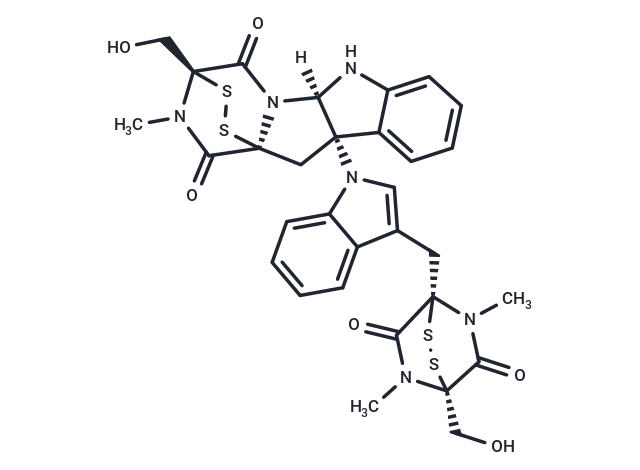Shopping Cart
- Remove All
 Your shopping cart is currently empty
Your shopping cart is currently empty

Chetomin (BRN0077366) is an inhibitor of HIF-1 by weaken transcription of HIF-1, disrupting the binding of HIF-1α and HIF-2α to p300 at low nanomolar concentrations.

| Pack Size | Price | Availability | Quantity |
|---|---|---|---|
| 1 mg | $98 | Backorder | |
| 2 mg | $175 | Backorder | |
| 5 mg | $316 | Backorder | |
| 10 mg | $506 | Backorder |
| Description | Chetomin (BRN0077366) is an inhibitor of HIF-1 by weaken transcription of HIF-1, disrupting the binding of HIF-1α and HIF-2α to p300 at low nanomolar concentrations. |
| In vitro | HIF-1 (hypoxia-inducible factors 1) is transcription factor which respond to changes of cellular environment oxygen[2]. Chetomin selectively inhibits HIF-1 activities through disruption of the interaction of HIF-1 with its transcriptional coactivator p300. HIF-1 inhibition by chetomin effectively reduces hypoxia-dependent transcription and radiosensitizes hypoxic HT 1080 human fibrosarcoma cells in vitro[1]. Chetomin attenuates the hypoxia-induced radioresistance of malignant glioma cell lines U251 mg (DMF10: 1.35 and 1.18) and U343 mg (DMF10: 1.78 and 1.48)[3]. Targeting of HIF-1 using chetomin abolishes the differentiation-inhibitory effect of hypoxia-inducible factor-1α[4]. |
| In vivo | Administration of chetomin in combination with forskolin significantly suppresses malignant glioma growth in an in vivo xenograft model [4]. Che-M(chetomin loaded micelles) dramatically inhibits embryonic angiogenesis, tumor-induced angiogenesis and tumor growth in zebrafish. In mouse model, Che-M suppresses tumor growth and prolongs the survival in the subcutaneous CT26 tumor model [5]. |
| Cell Research | In RT-PCR and clonogenic survival experiments, chetomin is added in a concentration of 150 nM to fully supplemented medium four hours before treatment with hypoxia. HT 1080 cells are then transferred to the hypoxic workstation (0.1% O2, 12 h) or to the well-humidified incubator (12 hours) without changing medium. HT1080 cells are thus treated for 16 hours with chetomin (150 nM) prior to radiation treatment. (Only for Reference) |
| Alias | NSC289491, Chaetomin, BRN0077366 |
| Molecular Weight | 710.87 |
| Formula | C31H30N6O6S4 |
| Cas No. | 1403-36-7 |
| Relative Density. | 1.78 g/cm3 |
| Storage | Powder: -20°C for 3 years | In solvent: -80°C for 1 year | Shipping with blue ice. | ||||||||||||||||||||||||||||||||||||||||
| Solubility Information | Ethanol: 10 mg/mL (14.07 mM), Sonication is recommended. H2O: <1 mg/mL DMSO: 93 mg/mL (130.83 mM), Sonication is recommended. | ||||||||||||||||||||||||||||||||||||||||
Solution Preparation Table | |||||||||||||||||||||||||||||||||||||||||
Ethanol/DMSO
DMSO
| |||||||||||||||||||||||||||||||||||||||||

Copyright © 2015-2025 TargetMol Chemicals Inc. All Rights Reserved.